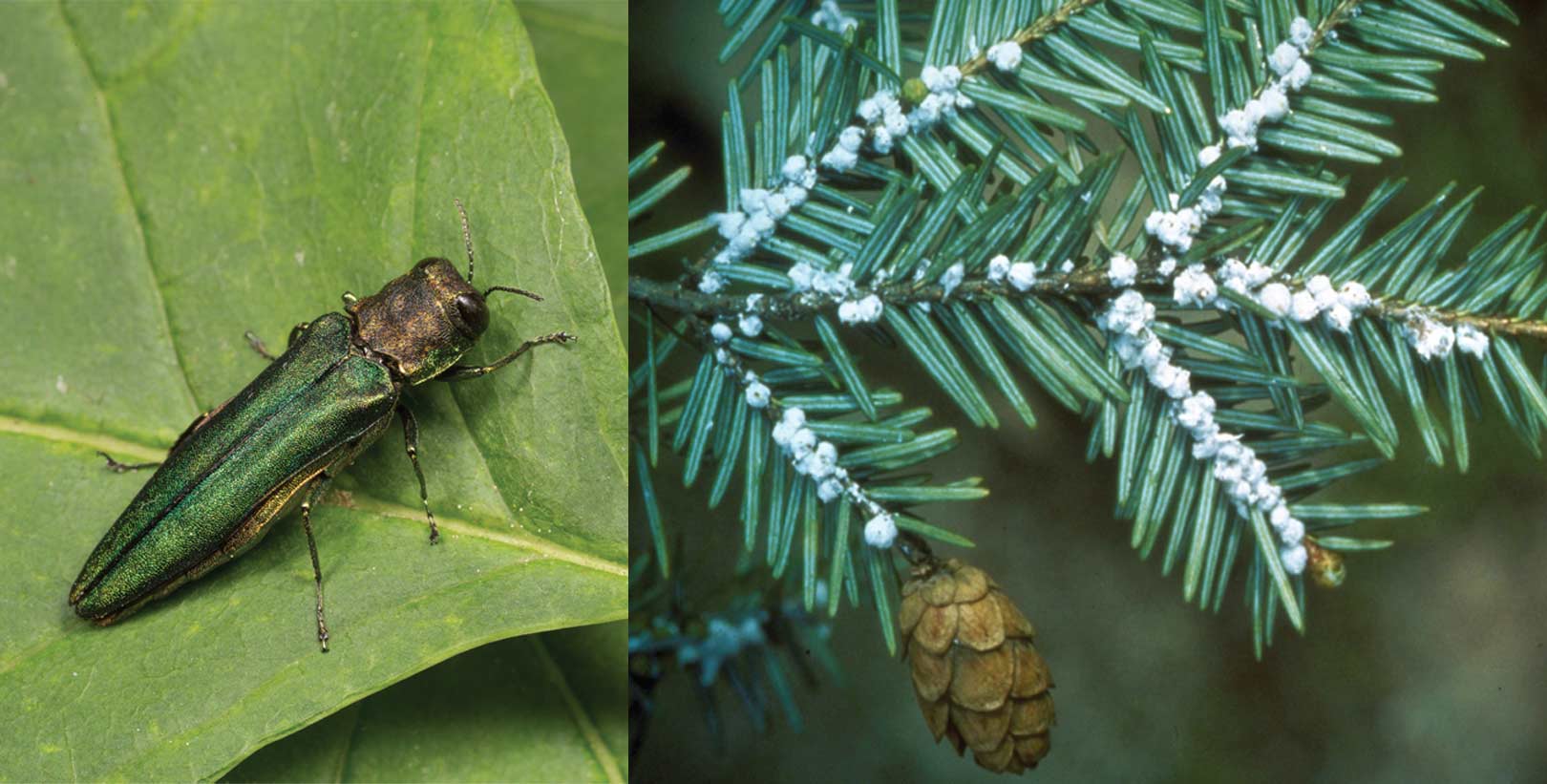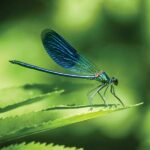
Hardwood trees such as the American ash are important locations for stick nests, often built by raptors, while cavity nests – frequently drilled in beech trees by woodpeckers – are important for small forest mammals as well as birds.
There’s a war in the woods throughout the region. The enemies are silent killers, the damage they do is often not seen until too late, and the stakes are high – the biodiversity of our forests. On one side of the struggle are invasive insects and other organisms, the unintended negative consequence of a shrinking planet and the global trade that gives these travellers free passage to ports around the world. In their home territories, these invaders are kept in check by natural balances; these include organisms that prey on them and those trees that have developed resistance over millennia. But in new territory, such as the forests of eastern North America, they go unchallenged without predators, giving them the capacity to threaten once-common tree species such as the butternut and the American ash – to name just two – with extinction in just a few decades. But there are glimmers of hope.
On the front line of defence of these threatened tree species are dedicated forest researchers. Their solutions often look to the mechanics of evolution and depend on observant forest and woodlot managers to keep watch for the survivors, on whom the future of some tree species may depend.
AMERICAN ASH
If the opening words of this article appear overly dramatic, then consider the decline of the American ash. Until recently a common component of eastern forests, the American ash is valued as a hardwood, notably for tool handles, furniture frames and baseball bats – and as a large shade tree in urban and park settings.
While the American ash is perhaps the most widely recognized species, black ash is also common in our area, where it is an important component of wetland forests.
The outlook for ash is grim, with some experts predicting the functional extirpation of the ash genus in North America.
Its enemy – the emerald ash borer – was first noticed in the Detroit area only 20 years ago, although it is believed to have been present since the 1990s. In the regions of China, Korea and eastern Russia where the borer is native, it kills only stressed and unhealthy trees. However, since its arrival in North America – likely on shipping materials – it has killed hundreds of millions of trees, attacking all 16 of our continent’s ash species and threatening all the continent’s eight billion ash trees. Once infected, trees die within two years.
Todd Farell, Natural Heritage Manager for the Northumberland County Forest, says the majority of the trees in the forest have been hit.
Treatment options are limited, particularly for trees in forest settings. To reduce contamination, “We have been removing any dead or dying trees along the trails within the forest,” Farrell says.
The United States Department of Agriculture has seen some success with biological control in the form of a parasitic wasp, native to eastern Russia, which is showing some ability to reduce ash borer populations and is able to spread to new areas infested by the insect. Between the introduced predator and a hoped-for natural resistance in a small percentage of trees, the ash may have a chance.
BUTTERNUT
Across their entire natural range in North America, butternut trees are under attack by the butternut canker, a deadly fungal disease believed to have originated in Asia. First discovered in Wisconsin, it has now spread into other states and Canada, including Ontario, where the butternut has been designated an endangered species.
The Butternut Recovery Program, based out of the Rideau Valley Conservation Authority, is banking on the theory that a small number of tree species impacted by invasive predators will show resistance and provide the foundation for a new generation of healthy trees, thanks to genetic diversity and the processes of evolution.
Through contact with landowners, the Butternut Recovery Program locates, assesses and maps healthy butternut trees which are then logged in a seed-source database. Seeds are collected from healthy trees and those showing signs of tolerance are planted and nurtured as seedlings at the Ferguson Forest Centre in Kemptville for the landowner planting program. The program annually distributes 2,000 seedlings to landowners across Eastern Ontario and tracks the survival and health of the planted butternuts.
So far, the program is showing signs of success. About 30 percent of the trees planted by the Butternut Recovery Program have survived. They may also possess the genetics that will beat the butternut canker.
AMERICAN BEECH
Nut trees such as the butternut and the American beech are an important food source for birds and other animals. Their disappearance from the forests of Southern Ontario threatens to disrupt the entire ecosystem as food chains change.
Beech bark disease occurs when an invasive insect, introduced from Europe more than a century ago, feeds on the bark of the tree, creating cracks that allow a native canker fungus to enter. Between 50 and 85 percent of infected beech trees will die within 10 years of infestation.
First seen in Nova Scotia, the disease has spread to Ontario as well as a number of states in the American northeast. Bill Newell, a forest technician who has worked in Northumberland and nearby counties for more than four decades, calls the disease “insidious.” Although living beech can still be found in area forests, any tree over about four inches in diameter is “showing some problems,” says Newell. By the time they reach 10 inches in diameter, they’re usually dead. “Every winter more of them are crashing to the ground.”
With no beech recovery program in place, disease management is left to landowners. Recommended practices include retaining large trees that show no sign of disease and treating sprouts emerging from the stumps of infested trees with herbicide. Those trees showing no signs of disease may be part of the one to five percent of beech fully resistant to the disease, which will form the basis of future stands.
AMERICAN ELM
The American elm, with its distinctive umbrella-shaped form, was once common in Southern Ontario. Unfortunately, Dutch elm disease, a fungus with its origins in Asia, arrived in Eastern Canada in the 1940s and by the 1970s, most of the majestic elms in Ontario were gone from the landscape. But perhaps not forever.
In the 1990s, horticulturist Henry Kock noticed that some elms appeared to have survived infection. With the help of the media, the Elm Recovery Project at the University of Guelph identified 800 apparently disease-resistant trees spread across the province and began what the press called a “dating service” for the single trees.
The best of these trees have been screened through inoculation trials, and the top performers are being produced for distribution to satellite orchards around the province. The hope is that by boosting local gene pools with pollen from disease-tolerant elms, the favourable traits from those elms will be passed along to future generations of genetically diverse elm seedlings.
If those efforts are successful, it’ll be thanks to an observant horticulturist and those landowners who assisted in his quest for healthy elms.
EASTERN HEMLOCK
If you go into the deep woods of our region, you will still find plenty of hemlock – a shade-tolerant conifer capable of living 500 years and growing to heights of 100 feet. The bark of eastern hemlock is rich in tannin and was once one of the main commercial sources for the leather industry. The trees were often stripped of their bark and left to rot in the forest. Recently the hemlock has come under threat of the woolly adelgid, an insect native to Asia, which feeds by sucking sap from hemlock and spruce trees.
In Asia the pest is managed by natural predators and resistant trees. The same is true in Western Canada, where the insect is believed to have been present for thousands of years. It was first found in the east, in Maine, in the 1950s and has now spread to Georgia, Nova Scotia, and unfortunately, Southern Ontario. As of March 2023, affected areas include the Niagara Gorge, Fort Erie, Wainfleet, Pelham, Hamilton, and Grafton. Todd Farrell notes that there are only small areas of hemlock in the Northumberland Forest. “We have been monitoring the trees closely for hemlock woolly adelgid for the last three years.”
Trees typically die four to ten years after infestation. Survivors are usually weakened and often die from other causes. Researchers looking for a biological control of the woolly adelgid are having some success with a black lady beetle from Japan, and another beetle native to Western Canada.
There’s also some hope the spread of the adelgid might be curtailed by cold winters. Researchers in Connecticut noted a considerable dieback of adelgids, and forest regrowth after bitter winters in 1999-2000 and 2013-14.
If the hemlock in our forests dies back and then rebounds, it won’t be the first time and it won’t be quick. Studies of ancient pollens show a significant dieback in the species 5,000 years ago, lasting for 1,000 years before rebounding occurred. The take-home message is that diversity and evolution are powerful forces, but operate on a long time scale.
When we think of the loss of tree species, we might first think of the economic cost, but Bill Newell points out there’s a wildlife impact. Hardwood trees such as the American ash are important locations for stick nests, often built by raptors, while cavity nests – frequently drilled in beech trees by woodpeckers, are important for small forest mammals as well as birds. “It’s an awful shame,” says Newell of the habitat loss.
Recovery programs and research into biological control of invasive species appear to provide some promise for the future of our woods. But keeping them free of further pests in the future will require vigilance on the part of many sectors – from international trade to woodlot managers to small business people selling firewood.
To learn more about invasive threats to our forests, and what’s being done to help, please contact ontariowoodlot.com
Story by:
Norm Wagenaar




